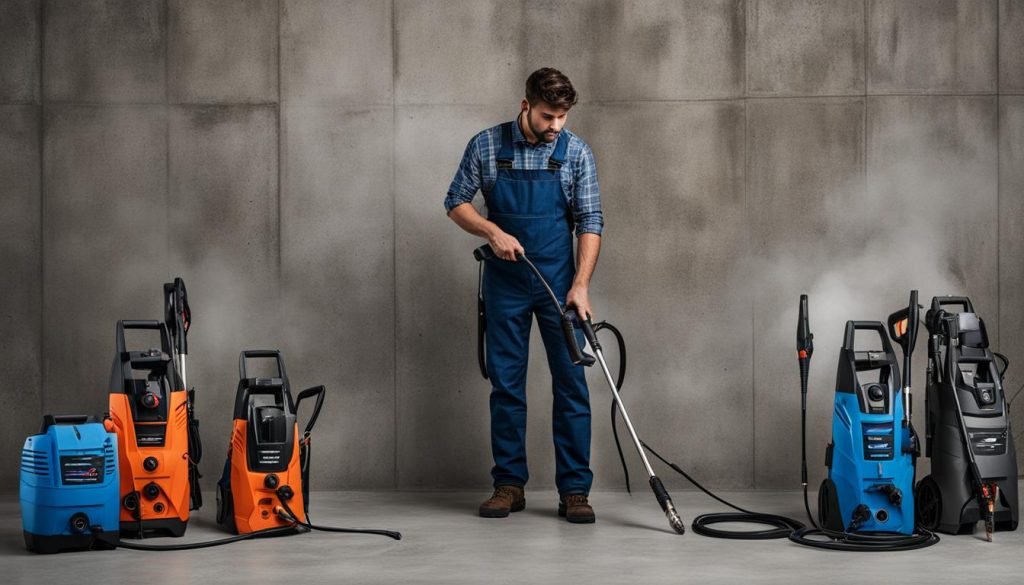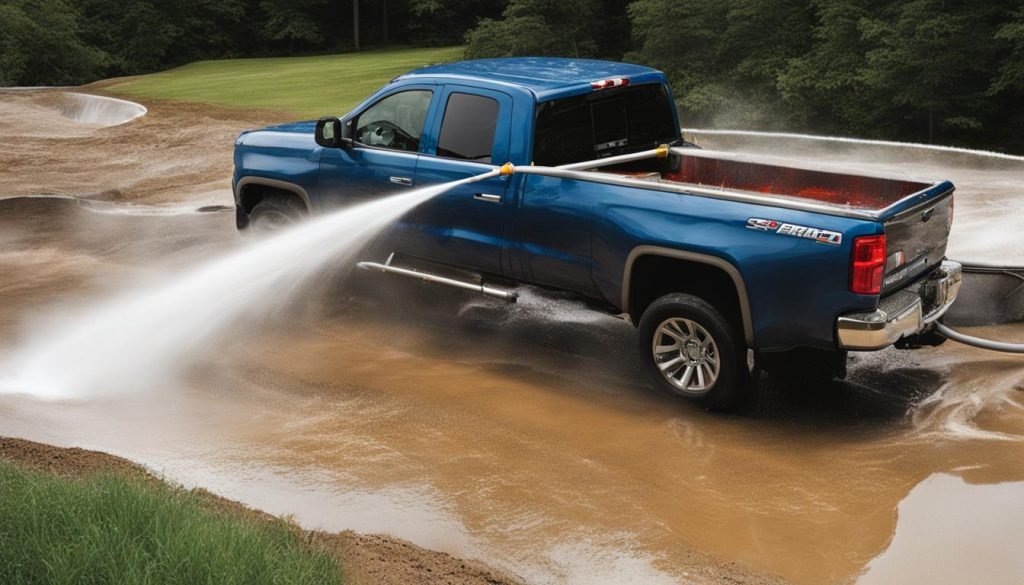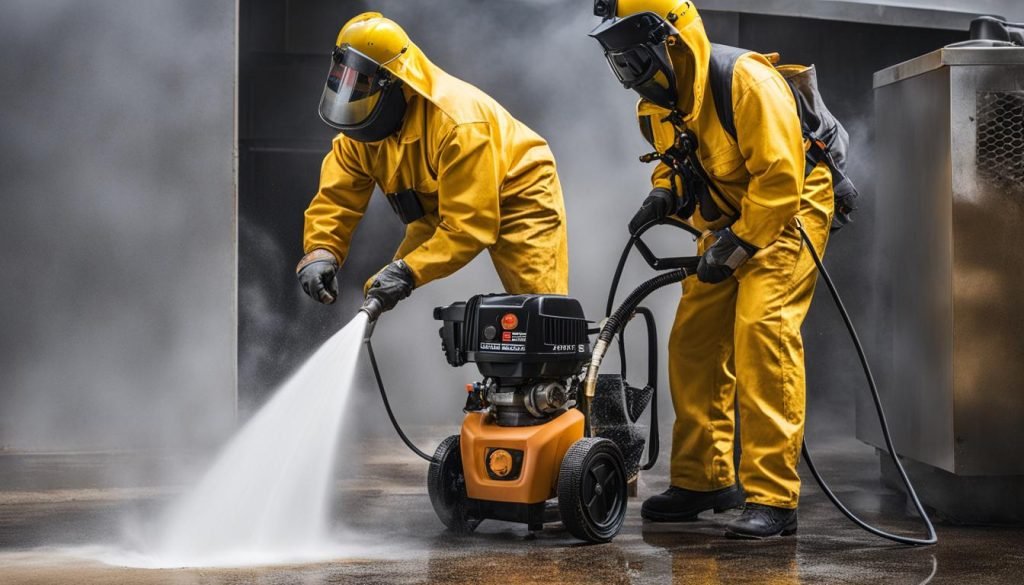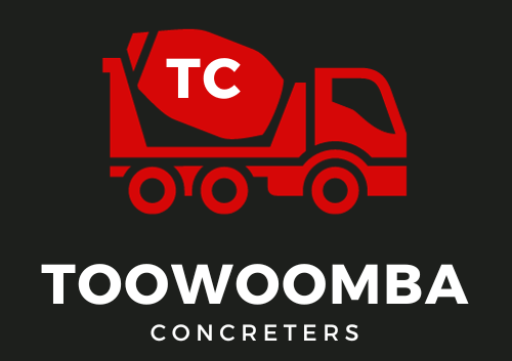
When it comes to cleaning concrete surfaces, selecting the right pressure is essential to achieve optimal results. The PSI (pounds per square inch) of your pressure washer plays a crucial role in determining its cleaning power. So, how much PSI do you need to clean concrete effectively? If you want more information, check out our Expert concreting solutions in Toowoomba for durable and stylish surfaces. Dive into this in-depth guide on How to Lay Concrete Driveway: Step-by-Step Instructions, offering detailed, step-by-step guidance. From prep to finishing touches, it encompasses every aspect of the concrete driveway installation process for a successful project.
The recommended PSI for cleaning concrete is at least 3000. This level of pressure is sufficient to remove dirt, stains, and other contaminants from concrete driveways, sidewalks, and patios. To complement the pressure, a flow rate of 4 gallons per minute (gpm) is also recommended for efficient cleaning.
However, it’s important to note that tougher stains, like paint or heavy tire marks, may require higher pressures. Additionally, the type of nozzle and the use of cleaning agents or degreasers can further enhance the cleaning process.
Key Takeaways:
- For effective concrete cleaning, the recommended PSI is at least 3000.
- A flow rate of 4 gpm complements the pressure for efficient cleaning.
- Tougher stains may require higher pressures.
- Consider the nozzle type and the use of cleaning agents or degreasers for enhanced cleaning.
Tips for Power Washing Concrete Surfaces
Before embarking on a power washing project for your concrete surfaces, there are several important tips to keep in mind to ensure optimal results. By following these guidelines, you can effectively clean and rejuvenate your concrete driveways, patios, and sidewalks.
- Plan your project: Allocate sufficient time for the power washing process as it may take anywhere between 2 to 4 hours, depending on the size of the area you’re cleaning.
- Dress appropriately: Prioritize safety by wearing long pants, sturdy shoes, gloves, and safety glasses to protect yourself from debris and high-pressure water.
- Pre-treat with a degreaser or concrete cleaner: Apply a degreaser or concrete cleaner before power washing to break down stubborn stains and dirt, making the cleaning process more effective.
- Start from the highest point: Begin power washing from the top and work your way down to ensure thorough cleaning without causing damage to the surface. Keep the nozzle about 12 inches away from the concrete to minimize the risk of surface etching.
- Use a steady sweeping motion: Move the nozzle in a back and forth motion across the concrete, overlapping each pass, to achieve the best cleaning results.
- Allow the concrete to dry completely: After power washing, give the concrete ample time to dry before using the area. This will prevent slips and falls and also allow for better results when applying sealant.
- Consider sealing the concrete: To protect your freshly cleaned concrete surfaces from future stains and damage, consider applying a concrete sealant. This will extend the longevity of your concrete and maintain its appearance.
- Test on a small area: Before power washing the entire surface, it’s wise to test the pressure washer on a small, inconspicuous area to ensure it achieves the desired results.
Following these tips will help you achieve a thorough and successful power washing experience for your concrete surfaces, leaving them clean, revitalized, and ready to withstand the elements.
Choosing the Right Pressure Washer for Concrete Cleaning
When it comes to cleaning concrete surfaces, selecting the right pressure washer is key to achieving optimal results. With various options available, it’s important to choose a pressure washer that meets the specific requirements of concrete cleaning.
For effective concrete cleaning, it’s recommended to select a pressure washer with a PSI (pounds per square inch) rating of at least 3000. This level of pressure is capable of removing dirt, stains, and other contaminants from concrete driveways, sidewalks, and patios. Additionally, a flow rate of 4 gallons per minute (gpm) ensures efficient cleaning results.
There are different types of pressure washers to consider. Light-duty units that can be attached to a garden hose are suitable for small cleaning tasks. For larger concrete surfaces or commercial cleaning, it’s advisable to opt for bigger, commercial-grade machines.
Gas-powered and electric models are both available, each with its own advantages. Gas-powered pressure washers offer higher power and are ideal for heavy-duty cleaning. Electric models, on the other hand, are more lightweight and suitable for smaller tasks.
In addition to the power source, it’s important to consider the reliability of the unit. Investing in a pressure washer with a triplex water pump and a reputable brand like Honda or Briggs and Stratton can ensure a durable and long-lasting machine.
Comparison of Pressure Washer Options
| Pressure Washer Type | Power Source | Recommended PSI | Flow Rate |
|---|---|---|---|
| Light-Duty | Garden Hose | 2000-2500 | 1.2-2 gpm |
| Gas-Powered | Gasoline | 3000+ | 4 gpm |
| Electric | Electricity | 2000-2500 | 1.2-2 gpm |
| Commercial-Grade | Gasoline or Diesel | 3000+ | 4-8 gpm |
When cleaning large horizontal concrete surfaces, such as driveways or patios, using wheel-mounted or walk-behind surface cleaners can significantly increase cleaning speed. These attachments typically feature multiple nozzles and spinning bars, allowing for efficient cleaning over wide areas.
Choosing the right pressure washer for concrete cleaning involves considering factors such as power, water flow rate, and reliability. By selecting a pressure washer with a minimum PSI of 3000 and a flow rate of 4 gpm, you can ensure effective cleaning and achieve the best results.
Hot Water vs. Cold Water Pressure Washers for Concrete Cleaning
When it comes to choosing the right pressure washer for concrete cleaning, one of the key considerations is whether to opt for a hot water or cold water machine. Both options have their advantages and it’s important to understand the differences to make an informed decision.
Hot Water Pressure Washers
Hot water pressure washers are known for their fast and efficient cleaning results. The high temperature of the water helps to break down and dissolve stubborn stains, especially oil and grease. This makes hot water machines particularly effective for industrial or commercial settings where heavy-duty cleaning is required.
While hot water pressure washers offer superior cleaning power, it’s worth noting that they are typically more expensive than their cold water counterparts. Additionally, hot water machines tend to be heavier and bulkier, which can impact maneuverability and ease of use.
Cold Water Pressure Washers
Cold water pressure washers, on the other hand, are more affordable and lightweight. They are suitable for a wide range of applications, including residential use. Cold water machines are effective in removing dirt and grime from concrete surfaces but may require more effort and time for deep cleaning.
Although cold water pressure washers are not as powerful as hot water units, they offer versatility and ease of operation. These machines are typically more compact and easier to maneuver, making them a popular choice for homeowners and small businesses.
Ultimately, the choice between hot water and cold water pressure washers depends on specific cleaning needs and budget constraints. If you need to tackle tough stains or heavy-duty cleaning tasks, a hot water machine may be the best option. However, if you’re looking for a cost-effective and versatile cleaning solution, a cold water pressure washer will suffice.
Regardless of the choice you make, it’s essential to ensure that the pressure washer you select has the proper pressure for concrete cleaning. An optimal pressure for concrete cleaning is typically at least 3000 PSI, with a flow rate of 4 gallons per minute (GPM). This will ensure effective removal of dirt, stains, and other contaminants from concrete surfaces.
Take a look at the table below for a quick comparison of hot water and cold water pressure washers:
| Hot Water Pressure Washers | Cold Water Pressure Washers | |
|---|---|---|
| Cleaning Power | High | Moderate |
| Effectiveness on Oil and Grease Stains | Excellent | Good |
| Cost | Higher | Lower |
| Weight and Size | Heavier and bulkier | Lightweight and compact |
Keep in mind that regardless of the temperature of the water, it’s important to follow proper safety precautions when using a pressure washer. Wear appropriate protective gear, such as gloves, safety glasses, and closed-toe shoes, and be mindful of the pressure and spray distance to prevent injuries or damage to the concrete surfaces. Always consult the manufacturer’s instructions for specific guidelines on operating your chosen pressure washer.
Next, we’ll explore the importance of routine maintenance for power washers and the steps you can take to keep your machine in optimal condition.
The Importance of Routine Maintenance for Power Washers
All power washers require regular maintenance to ensure optimal performance and longevity. Neglecting routine maintenance can result in decreased efficiency, increased repair costs, and shortened lifespan of the power washer. By following these operating tips for maintenance, you can keep your power washer in excellent working condition for years to come.
Never Run the Pressure Washer Without Water
Running the power washer without water can cause significant damage to the pump. The water acts as a lubricant, cooling agent, and sealant for the pump components. Without water, the heat generated by the pump can quickly wear out seals, O-rings, and other critical parts. To prevent premature pump seal failure, always make sure there is a constant water supply flowing through the power washer while it’s in operation.
Avoid Running the Power Washer in Bypass for Extended Periods
Bypass mode allows water to circulate within the power washer without being discharged. While this mode can be used temporarily during certain cleaning tasks, running the power washer in bypass for extended periods can lead to overheating and damage to the pump. It’s essential to switch off the power washer when not in use to prevent excessive pressure buildup and stress on the components.
Ensure Proper Water Volume
The water source must provide an adequate volume of water for the pump to function effectively. Insufficient water volume can strain the pump and cause cavitation, leading to premature wear and tear. Make sure the water source can supply the required gallons per minute (gpm) as specified in the power washer’s manual. If the water volume is too low, consider using a larger-diameter hose or increasing the water flow rate.
Regularly Check for Air in the Pump
Air trapped in the pump can cause pressure loss, unusual vibrations, and a hammering noise. It is crucial to release any air bubbles or pockets to prevent damage to the power washer. To remove air from the pump, follow these steps:
- Turn off the power washer.
- Disconnect the water supply.
- Squeeze the trigger on the spray gun to release any remaining pressure.
- Reconnect the water supply and turn on the power washer.
- Allow water to flow through the system for a few minutes before restarting the cleaning process.
Regularly checking for air in the pump will help maintain optimal performance and prevent damage to the power washer.
In conclusion, routine maintenance is essential for power washers to ensure their longevity and optimal performance. By adhering to these operating tips, including never running the power washer without water, avoiding extended periods of bypass operation, ensuring proper water volume, and regularly checking for air in the pump, you can significantly reduce repair costs and extend the lifespan of your power washer. Investing time and effort in maintenance will pay off in the long run, ensuring that your power washer continues to deliver excellent cleaning results for years.
Using Rotary Nozzles for Faster Cleaning
When it comes to concrete cleaning, the flow rate and nozzle type are crucial factors in determining the speed and effectiveness of the cleaning process. Higher flow rates are essential for heavily soiled surfaces, while vertical surfaces benefit less from increased flow rates due to gravity. To achieve faster and more efficient cleaning results on concrete surfaces, using rotary nozzles can be highly advantageous.
Rotary nozzles, also known as turbo nozzles, are designed to spin an undeflected water jet in a circular path. This spinning action prevents water deflection, allowing for greater precision and speed during the cleaning process. By combining the power of high-pressure water with the rotary motion, these nozzles can significantly increase the cleaning speed, ensuring thorough and effective results.
Rotary nozzles are particularly beneficial for removing stubborn stains, dirt, and grime from concrete surfaces. The concentrated force and spinning action of the water jet make it easier to break down and dislodge tough residues, resulting in faster cleaning times. Whether you’re cleaning driveways, patios, or sidewalks, rotary nozzles can help you achieve the pristine results you desire.
“Using rotary nozzles can significantly reduce cleaning time while still ensuring superior results on concrete surfaces.”
In addition to their speed and efficiency, rotary nozzles are also versatile and can be used with various pressure washer models. They come in different sizes and can be easily attached to the end of the pressure washer wand. It’s important to note that the flow rate and pressure should still be adjusted according to the specific cleaning requirements of the surface being cleaned.
Here’s a comparison table highlighting the advantages of using rotary nozzles for concrete cleaning:
| Advantages of Rotary Nozzles | Nozzle Type | Flow Rate |
|---|---|---|
| Increased cleaning speed | Rotary/turbo nozzle | Varies based on pressure washer model |
Note: Flow rate specifications will depend on the specific pressure washer model and nozzle size.
The Benefits of Wheel-Mounted Power-Washing Units

When it comes to cleaning large flatwork areas, such as driveways, sidewalks, or patios, efficiency and speed are key. That’s where wheel-mounted power-washing units come into play, offering significant benefits for achieving thorough and efficient cleaning results.
Increased Cleaning Speed
Wheel-mounted power-washing units are specifically designed to enhance cleaning speed, especially on large horizontal surfaces. These units resemble lawn mowers, featuring nozzles mounted on spinning bars within a durable metal housing.
Using a wheel-mounted power washer is a game-changer when it comes to saving time and effort compared to using a standard power-washing wand. By utilizing a walk-behind washer, users can achieve greater productivity and easier maneuverability, leading to faster and more efficient cleaning of large flatwork areas.
With the spinning bars mounted on wheels, users can effortlessly guide the washer across the surface, allowing for even distribution of water and consistent cleaning results. This eliminates the need for excessive physical exertion and tedious back-and-forth movements, resulting in reduced fatigue and improved overall cleaning experience.
Efficient and Thorough Cleaning
Wheel-mounted power-washing units provide efficient and thorough cleaning on large flatwork areas due to their effective design. The spinning bars create a continuous stream of pressurized water, ensuring consistent coverage and powerful cleaning action across the entire surface.
By using a walk-behind washer, users can maintain a steady pace and effectively remove dirt, grime, stains, and other contaminants from the concrete surface. This method allows for greater control and precision, guaranteeing that no areas are missed or left untreated.
Whether it’s a residential driveway or a commercial parking lot, wheel-mounted power-washing units deliver exceptional cleaning performance, leaving behind a fresh and revitalized surface. This not only enhances the visual appeal but also promotes a clean and safe environment for both residents and visitors.
With their ability to increase cleaning speed and deliver efficient results on large flatwork areas, wheel-mounted power-washing units are a valuable asset for any cleaning professional or homeowner. Their ease of use and effectiveness make them a preferred choice for tackling extensive concrete cleaning projects with remarkable speed and precision.
Pre-Treating Stubborn Stains for Complete Removal
While pressurized water can effectively remove most dirt and stains from concrete surfaces, pre-treating stubborn deposits is essential to ensure complete removal during the pressure cleaning process. Certain stains, such as oil, rust, or graffiti, can be particularly challenging to eliminate with water alone. To achieve the best results, pre-treatment with appropriate cleaning agents or degreasers is highly recommended.
By using specialized cleaning agents, you can break down and dissolve tough stains, making them easier to remove with the pressure washer. These products are specifically formulated to tackle different types of stubborn deposits, ensuring a thorough and pristine result on concrete surfaces. Whether you’re dealing with oil stains from a leaky car, rust marks from metal objects, or graffiti from vandals, pre-treating these stains with cleaning agents will significantly enhance the effectiveness of the pressure cleaning process.
When selecting cleaning agents for concrete cleaning, it’s crucial to choose products that are safe for both the user and the environment. Look for eco-friendly options that are specifically designed for concrete surfaces. These products not only deliver excellent cleaning performance but also minimize the risk of damage to the concrete and surrounding vegetation.
Benefits of pre-treating stubborn stains:
- Breaks down and dissolves tough stains
- Enhances the effectiveness of pressure cleaning
- Achieves a thorough and pristine result
By incorporating pre-treatment with cleaning agents into your concrete cleaning routine, you can ensure complete stain removal and maintain the aesthetic appeal of your surfaces. Now, let’s take a look at some commonly used cleaning agents and their effectiveness in removing specific types of stains:
| Cleaning Agent | Effective Against |
|---|---|
| Concrete degreasers | Oil and grease stains |
| Rust removers | Rust marks |
| Graffiti removers | Graffiti |
“Pre-treating stubborn stains with the right cleaning agents is a game-changer in the pressure cleaning process. By breaking down and dissolving tough stains, these products ensure complete removal, leaving your concrete surfaces looking as good as new.”
Safety Precautions for Power Washing Concrete

When it comes to power washing concrete, user safety should always be a top priority. The high-pressure water used in power washing can pose potential risks if not handled properly. To ensure a safe and efficient concrete cleaning experience, it is crucial to follow these safety precautions and wear the appropriate protective gear.
- Protective Gear: Before starting the power washing process, make sure to wear the necessary protective gear. This includes a mask to shield your face from flying debris and water droplets, gloves to protect your hands and provide a better grip on the equipment, boots to prevent slipping on wet surfaces, and clothing with long pants and sleeves to cover your skin and minimize the risk of injuries.
- Maintain a Safe Distance: Keep a safe distance from the surface being cleaned to avoid potential injuries. The force of the high-pressure water can cause kickback or spray back, which can be dangerous if you are too close. Maintain a distance of at least 12 inches from the surface.
- Be Mindful of Surroundings: Before starting the power washer, ensure that the area is clear of any obstacles or fragile items that could be damaged by the high-pressure water. Also, be cautious of nearby electrical outlets or power sources, and avoid using the power washer near them to prevent electrical hazards.
- Proper Handling of the Equipment: Familiarize yourself with the operation and handling of the power washer before use. Follow the manufacturer’s instructions for safe usage, including how to start and stop the equipment correctly and how to handle any emergency situations that may arise.
- Eye and Ear Protection: Power washing can be loud and may generate debris, so wearing safety glasses or goggles can protect your eyes from potential hazards. Additionally, consider using ear protection to reduce the noise level and protect your hearing.
By adhering to these safety precautions and wearing the appropriate protective gear, you can ensure a safe power washing experience and minimize the risk of injuries. Always prioritize your safety and the safety of those around you when power washing concrete surfaces.
Note: The image below depicts a person wearing protective gear while power washing concrete.
Spring Cleaning and Regular Power Washing
Spring is the best time for power washing your concrete surfaces, especially when it is done as part of a regular cleaning schedule. By incorporating power washing into your maintenance routine, you can keep your home’s exterior looking clean and vibrant all year round.
Regular power washing is essential to maintain the cleanliness and appearance of concrete surfaces. It helps to remove dirt, grime, and buildup that accumulate over time, preventing them from becoming stubborn stains. By eliminating these contaminants, you can preserve the integrity and longevity of your concrete surfaces.
It is recommended to power wash your home’s exterior at least once each spring and fall. This regular cleaning schedule ensures that your concrete surfaces remain in optimal condition throughout the year. By staying consistent with your power washing routine, you can prevent the buildup of stubborn stains and maintain the visual appeal of your property.
To make the most of your power washing efforts, consider the best time to power wash: Spring, when the weather is mild and conducive to outdoor cleaning activities. The moderate temperatures and decreased chance of rain provide an ideal environment for achieving excellent cleaning results.
When power washing in the spring, pay attention to weather conditions and choose a day with calm winds and no chance of rain. This will ensure that the cleaning process is smooth and efficient, without any interference from the elements.
By following a regular cleaning schedule and incorporating power washing into your maintenance routine, you can keep your concrete surfaces looking their best and extend their lifespan. Take advantage of the spring season, and give your home’s exterior a refreshing and rejuvenating power wash.
Benefits of Regular Power Washing:
- Prevents the buildup of dirt, grime, and stains
- Preserves the visual appeal of concrete surfaces
- Extends the lifespan of your concrete surfaces
- Maintains the overall cleanliness of your property
- Enhances curb appeal and property value
Conclusion
When it comes to cleaning concrete, selecting the right pressure is crucial for achieving optimal results. A pressure washer with a minimum PSI rating of 3000, combined with a flow rate of at least 4 gpm, is recommended for effective concrete cleaning. This level of pressure is sufficient for most cleaning jobs, removing dirt, stains, and other contaminants from concrete surfaces.
Using the proper nozzle type can also enhance the cleaning process. Consider pre-treating stubborn stains with appropriate agents or degreasers before power washing to ensure complete removal. It’s important to follow safety precautions and wear protective gear, such as a mask, gloves, boots, and long clothing, to minimize the risk of injuries. Additionally, regular maintenance and incorporating power washing into a cleaning schedule are essential for maintaining the cleanliness and longevity of concrete surfaces.
By following these guidelines and utilizing the recommended PSI for pressure washing concrete, you can achieve pristine results and keep your concrete surfaces looking their best. Proper pressure for concrete cleaning, combined with the right techniques and equipment, will help you effectively clean your concrete and maintain its durability and appearance for years to come.
FAQ
How much PSI is recommended for cleaning concrete?
The recommended PSI for cleaning concrete is at least 3000 PSI.
What flow rate is recommended for cleaning concrete?
A flow rate of 4 gallons per minute (gpm) is recommended for cleaning concrete.
What is the best time to power wash concrete?
Spring is often considered the best time to power wash concrete, as part of regular maintenance.
What should I wear when power washing concrete?
It is recommended to wear long pants, sturdy shoes, gloves, and safety glasses when power washing concrete.
Should I pre-treat stubborn stains before power washing concrete?
Yes, pre-treating stubborn stains with cleaning agents or degreasers can help achieve better results when power washing concrete.
Should I seal concrete after power washing?
It is recommended to consider sealing the concrete after it has dried completely for added protection and longevity.
What type of pressure washer should I use for cleaning concrete?
It is recommended to use a pressure washer with a minimum PSI rating of 3000 and a flow rate of 4 gpm for cleaning concrete.
Should I use a hot water or cold water pressure washer for cleaning concrete?
Hot water pressure washers are often preferred for cleaning concrete, as they provide faster and more efficient cleaning results, especially for oil and grease stains. However, cold water pressure washers can also effectively clean concrete surfaces.
How often should I perform maintenance on my power washer?
Regular maintenance is important for optimal performance and longevity of your power washer. It is recommended to follow the manufacturer’s guidelines for maintenance and address any issues promptly.
How do I choose the right nozzle for cleaning concrete?
The choice of nozzle depends on the desired cleaning action. For fast and efficient cleaning, a rotary nozzle that spins an undeflected water jet in a circular path is recommended for concrete surfaces.
What are the benefits of using wheel-mounted power-washing units for cleaning concrete?
Wheel-mounted power-washing units, similar to lawn mowers, can increase cleaning speed, especially on large horizontal surfaces. They provide greater productivity and easier cleaning on large flatwork areas.
Why is it important to follow safety precautions when power washing concrete?
Power washing involves high-pressure water that can pose a risk to user safety if not handled properly. Wearing protective gear, such as a mask, gloves, boots, and long pants and sleeves, is essential to minimize the risk of injuries during the power washing process.
What is the role of routine power washing in maintaining concrete surfaces?
Regular power washing helps to remove dirt, grime, and buildup from concrete surfaces, preventing them from becoming stubborn stains over time. Incorporating power washing into a regular cleaning schedule can help maintain the cleanliness and longevity of concrete surfaces.
Source Links
- https://skbuildingservices.com/how-much-psi-to-clean-concrete/
- https://www.concretenetwork.com/concrete/cleaning_concrete/equipment_options.htm
- https://www.daimer.com/blog/how-to-clean-concrete-surfaces-and-floors-using-pressure-washer/



